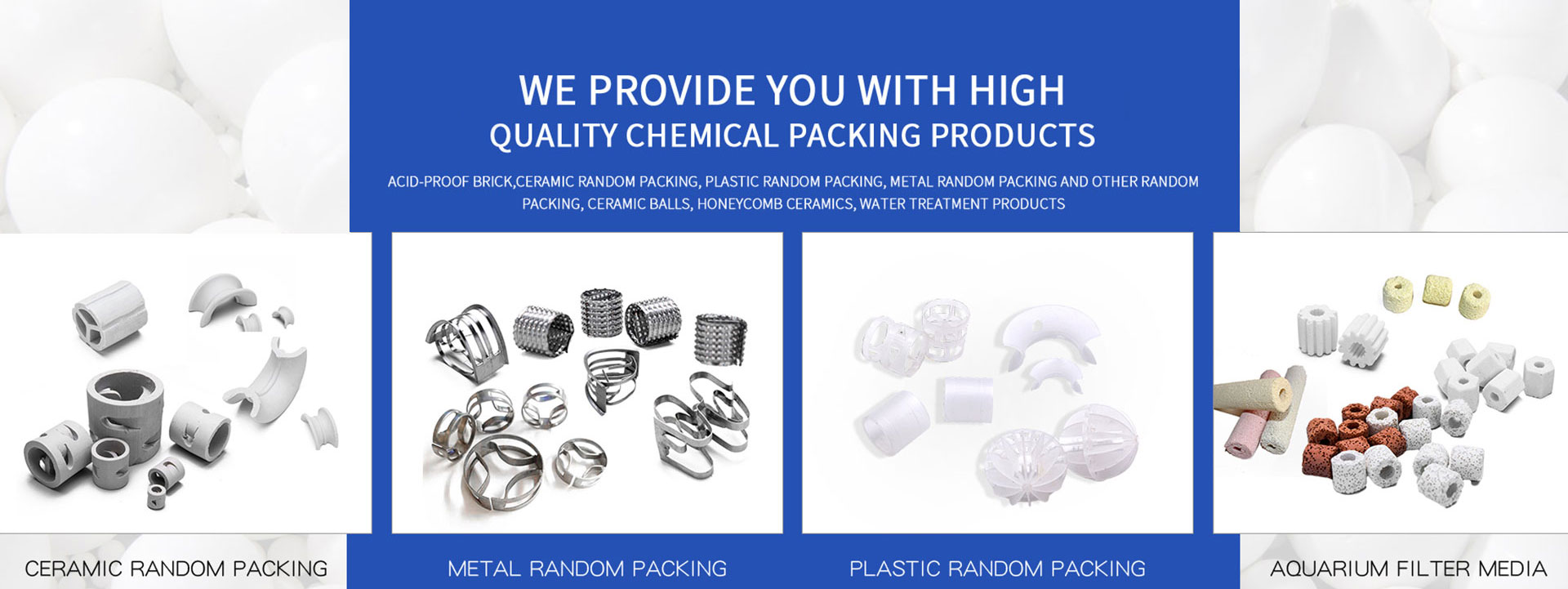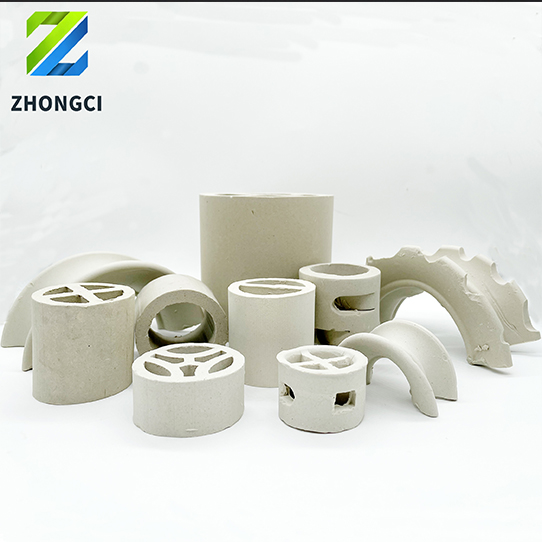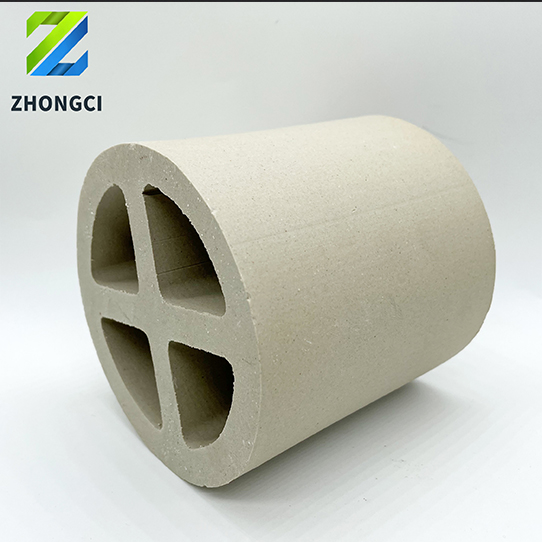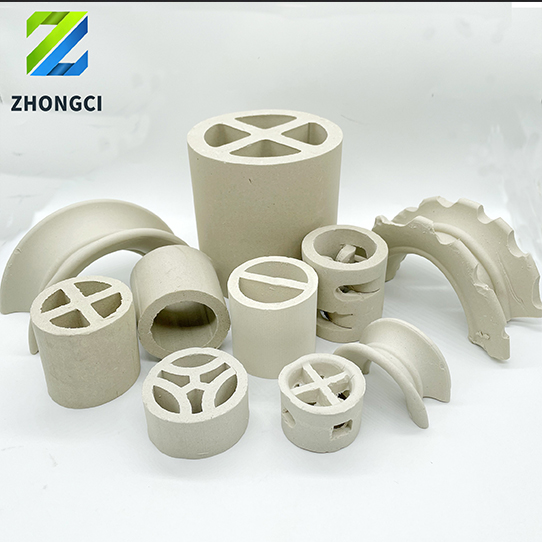


Ceramic Cross Partition Ring – Advance Products of Ceramic Raschig Ring
Ceramic cross ring is improved by ceramic raschig ring. It has better surface area and compressive strength than raschig ring. Additional, it has excellent acid resistance and heat resistance performance.
It can withstand various inorganic acids, organic acids and organic solvents except hydrofluoric acid, and can be used in high or low temperature conditions.
Quick Details

Ceramic cross ring has large surface area and high compressive strength.

Different sizes are supplied and custom order are also available.
Introduction to Ceramic Cross Partition Ring
The Ceramic Cross Partition Ring is a modification of the traditional Raschig Ring. It builds upon the basic structure of the Raschig Ring by adding a cross partition, which results in a cross-shaped opening. This design increases the surface area of the packing material, enhancing mass transfer efficiency. The ceramic cross partition ring offers several benefits, including better compressive strength and higher performance in various industrial applications.
Design and Structure of the Ceramic Cross Partition Ring
The Ceramic Cross Partition Ring features a similar structure to the traditional Raschig Ring but with the addition of a cross-shaped partition. This unique design increases the specific surface area of the packing material, which directly improves mass transfer efficiency. The cross-shaped openings create more contact points for gas and liquid phases, leading to more effective separation or absorption processes.
The larger size of the ceramic cross partition rings makes them suitable for regular stacking arrangements, particularly as support materials for random packing layers at the bottom of towers. This design enables the Ceramic Cross Partition Ring to provide better flow distribution and a more stable packing structure.
Key Features of the Ceramic Cross Partition Ring
Increased Surface Area: The addition of the cross partition increases the packing surface area, which improves mass transfer efficiency. This is particularly beneficial in processes that require high contact between phases, such as absorption and distillation.
High Compressive Strength: The ceramic material and the cross partition structure provide excellent compressive strength, making the Ceramic Cross Partition Ring highly durable and able to withstand the mechanical stresses typically encountered in industrial environments.
Excellent Resistance to Chemicals and Heat: The ceramic material offers outstanding resistance to a wide range of inorganic acids, solvents, and high temperatures, except for hydrofluoric acid. This makes the ceramic cross partition ring suitable for aggressive chemical environments.
Low Pressure Drop: The unique design of the ceramic cross partition ring reduces the pressure drop within the packing system, which improves the efficiency of the entire process.
Applications of the Ceramic Cross Partition Ring
The Ceramic Cross Partition Ring is widely used in several industries due to its versatility and enhanced performance. Its large size and high density make it suitable for use in both structured and random packing systems. Some of the most common applications include:
Chemical Industry: It is commonly used in drying towers, absorption towers, and washing towers, where efficient mass transfer and resistance to chemicals are essential.
Metallurgical Industry: The ceramic cross partition ring is used in gas separation and heat exchange processes in metallurgical operations.
Gas Industry: It plays an important role in cooling towers and scrubbers, where efficient contact between gas and liquid phases is needed.
Environmental and Water Treatment: It is used in water treatment and waste gas treatment processes, where high resistance to corrosion and heat is essential for long-lasting performance.
Advantages of Ceramic Cross Partition Rings
Increased Efficiency: The larger surface area and improved flow characteristics result in higher mass transfer rates, making the packing more efficient for gas and liquid interaction.
Durability: The ceramic material offers superior durability and can withstand harsh conditions, making it suitable for long-term use without requiring frequent replacements.
Low Production Waste: With recent breakthroughs in production technology, the yield rate of ceramic cross partition rings has increased to over 90%. This reduces material waste and shortens the production cycle, ensuring timely delivery to clients.
Versatility: The ceramic cross partition ring can be used in a wide range of industrial applications, including chemical, metallurgy, and environmental industries.
Conclusion
The Ceramic Cross Partition Ring is a highly efficient and durable packing material that offers improved mass transfer, better compressive strength, and exceptional resistance to heat and chemicals. Its unique design and superior performance make it an essential component in various industrial processes, including chemical processing, metallurgy, and environmental applications. With its growing range of uses and its ability to optimize tower performance, the Ceramic Cross Partition Ring is quickly becoming a vital material in many industries.
Applications
It is widely used in drying columns, absorbing coluinorganic acids, organic acids and organic solvents except hydrofluoric acid, and can be used in high or low temperature conditions.
Chemical properties of Ceramic cross ring | |||
SiO2+ Al2O3 | > 92% | CaO | < 1.0% |
SiO2 | > 76% | MgO | < 0.5% |
Al2O3 | > 17% | K2O + Na2O | < 3.5% |
Fe2O3 | < 1.0% | Other | < 1% |
Physical Properties of Ceramic cross ring | |||
Water Absorption | < 0.5% | Moh's Hardness | > 6.5 scale |
Porosity | < 1% | Acid Resistance | > 99.6% |
Specific Gravity | 2.3–2.4 g/cm3 | Alkali Resistance | > 85% |
Max. Operation Temp. | 1200 °C | ||
Common Specifications of Ceramic Cross Ring | ||||||
Item | Size | Thickness | Surface area | Voidage | Bulk Quantity | Bulk density |
CCRS-01 | 25 | 3.5 | 220 | 52 | 50000 | 850 |
CCRS-02 | 50 | 5.5 | 150 | 53 | 6400 | 800 |
CCRS-03 | 80 | 8 | 120 | 54 | 1960 | 916 |
CCRS-04 | 100 | 10 | 110 | 53 | 1000 | 930 |
CCRS-05 | 150 | 15 | 60 | 58 | 296 | 960 |
<< Previous page
Next page >>